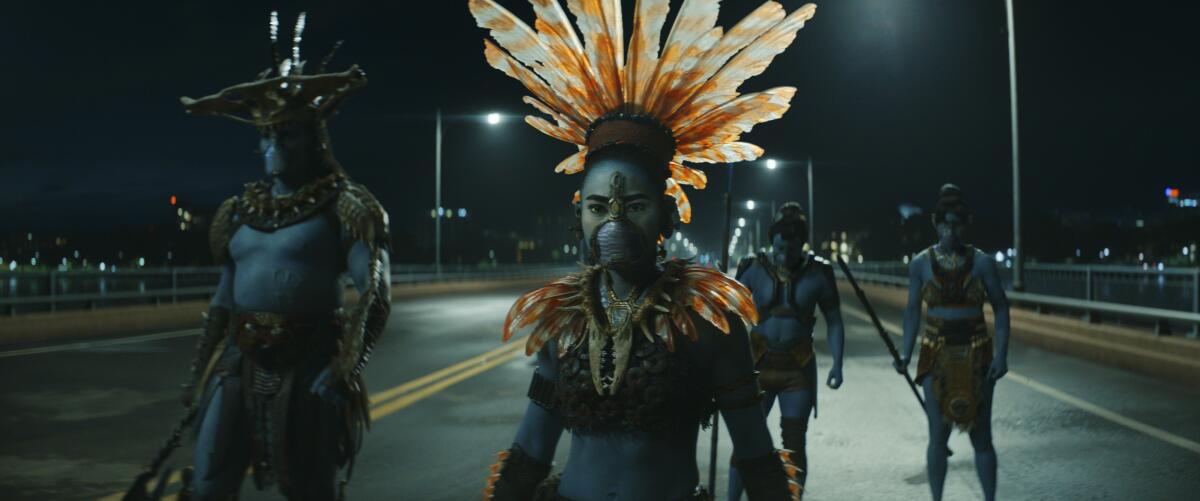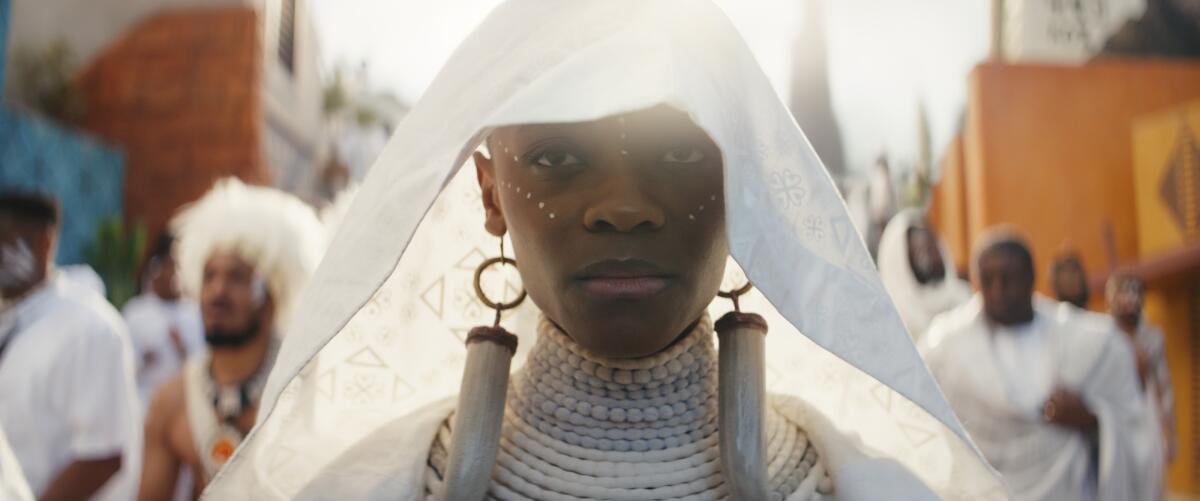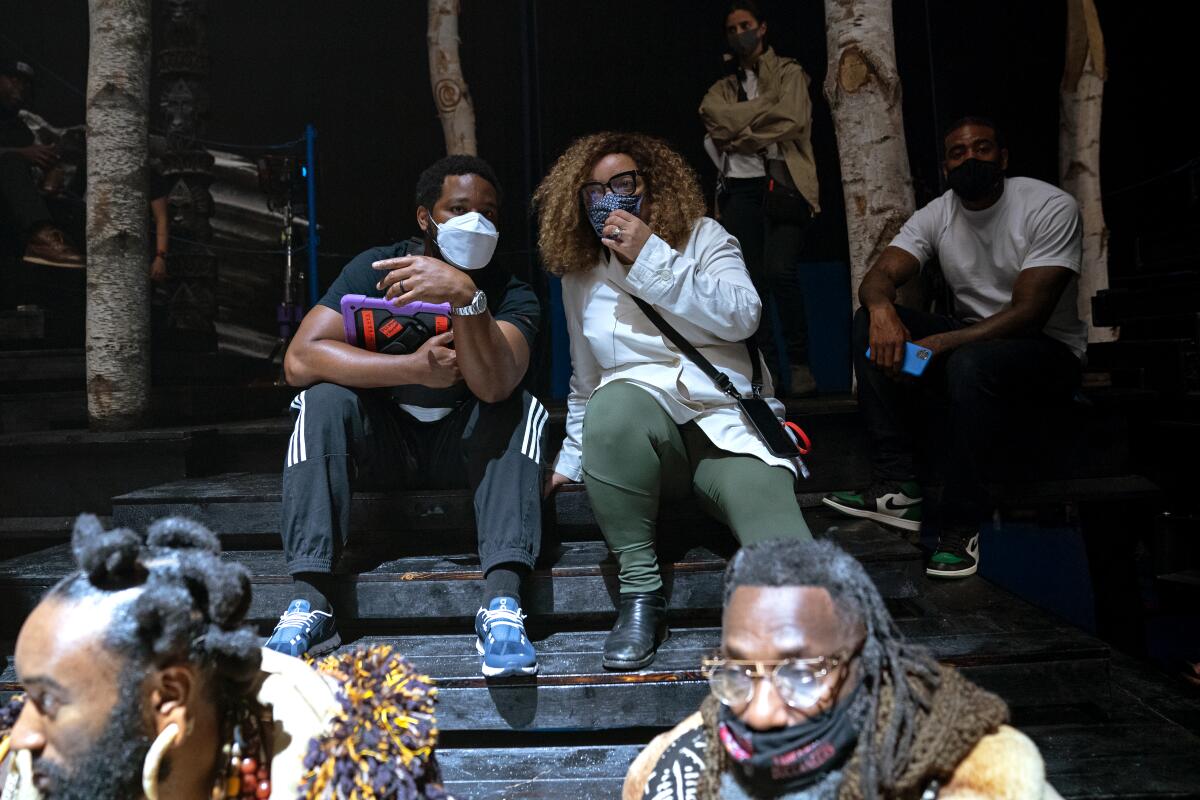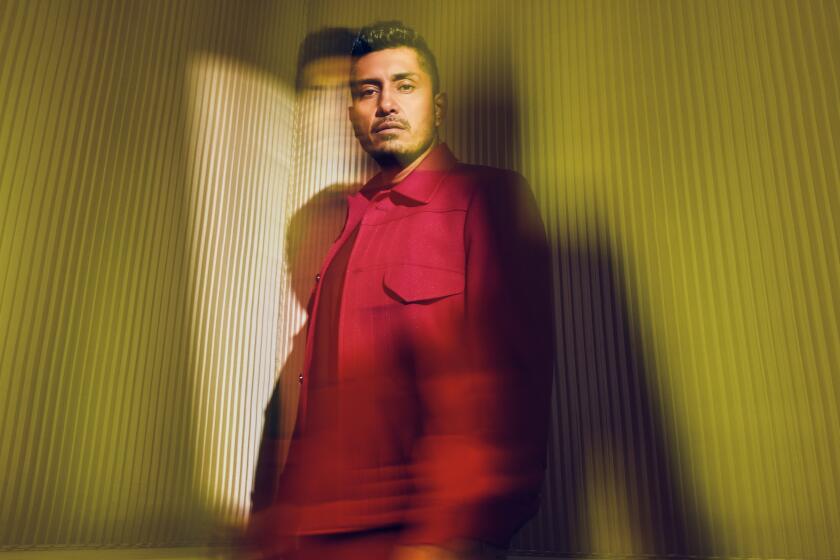‘Wakanda Forever’ spotlights women’s issues and power. And, oh, those costumes

- Share via
For Ruth E. Carter, returning to the vibrant world of Wakanda on “Black Panther: Wakanda Forever” was an emotional journey. Carter, who made history as the first Black costume designer to win an Academy Award, in 2019 for “Black Panther,” was forced to pivot her process partway through prep when star Chadwick Boseman died of cancer in 2020. His death meant that writer and director Ryan Coogler had to alter the story, which now opens with a funeral for Boseman’s T’Challa character.
Carter and her team had already begun designing costumes and reaching out to artisans around the world when everything came to a halt.
“We started out with a story about Chadwick, and then we lost him and we had no script,” Carter recalls. “We had to band together as a family without being able to physically embrace. Ryan Coogler became our hero, because we needed him to make the decision on what kind of story we’re going to tell now. And so we continued to create the art. That was done in a very personal and sensitive way where I still had to build this world, the kingdoms of Wakanda and the Talokan, the underwater world.”
One of the film’s most striking sequences comes early on as the people of Wakanda gather to honor the life of King T’Challa. The Wakandans wear funereal white, which is traditional in West African cultures. Coogler requested the team use “pure white,” which is notably difficult to shoot, so Carter used texture and detail to ensure that each tribe was distinctive.

“We unified all the tribes with this white color but where you can actually make out each tribe based on their beadwork or the fur that they had on their heads or the adornments that they wore,” Carter says. “I feel like the scene itself was so impactful when we shot it, because it was our turn to mourn together. It wasn’t until we actually shot the scene that we embraced and had a very emotional response. So I loved the white, and I loved it in the film. What a day of celebration of Chadwick.”
Although the silhouettes and aesthetic of Wakanda that Carter created in “Black Panther” are still apparent, the designer also wanted to evolve many of the looks worn by the key characters. Queen Ramonda, played by Angela Bassett, wears striking gowns and ornamental headdress crowns to signify that she now holds the throne of the African nation. The headdresses were 3-D-printed, as was her jeweled collar. The queen’s chest armor is intended to be made of Wakanda’s critical metallic ore Vibranium to represent her stature.
Everything you need to know about “Wakanda Forever”: Who is the new Black Panther? What is Namor’s backstory? Who is Ironheart? When is the release date?
“In the first film, she was in support of King T’Challa, and you saw her on the sidelines,” Carter says of Ramonda. “In this one she’s at the helm. I wanted to, as much as I could, show designs that indicated the power of women. So she wears one sleeve out of her dress — Shuri does as well when you first meet her — and to me that indicated feminine strength, vulnerability, beauty and power. Angela’s performance is always so powerful that I felt that we needed to design her costume to accent the work that we know that Angela brings every time she takes on a role.”
The Dora Milaje, an elite group of warriors who protect Wakanda, got a similar upgrade. Carter designed new armor for the soldiers with broader shoulders to give them a stronger silhouette. When their leader, Okoye, ventures to Boston, Carter needed a less obvious version of the uniform. She worked with Adidas’ S.E.E.D. program on a unitard that evoked the Dora Milaje armor and then paired it with a structured black Mugler jacket. The collaboration with Adidas was one of many on the film as Carter looked to artists, artisans and designers around the world to bring the designs to life, including Iris Van Herpen, JJ Valaya, Ozwald Boateng and Herve Leger.

“A film this big we like to think it’s one person’s grand idea, but it’s a lot of artists coming together with their aesthetics, and we’re sifting through and deciding which direction we want to go,” Carter says. “It’s a beautiful mosaic of designers and illustrators and artists whose thoughts and story bring all of that together, with Ryan as the yea and nay of it all.”
Another collaboration came in the form of the new Black Panther suit. As Shuri, played by Letitia Wright, takes over the superhero mantle from her late brother, she needed a costume to showcase her newfound power and to also pay tribute to T’Challa’s iconic look. The suit was designed by Ryan Meinerding at Marvel and actualized by Carter, who made some tweaks to ensure it looked right on a female body.
“We did not want to make this form so unrealistic from Shuri,” Carter says. “She’s like a ballerina. She has this musculature that, I think, enhances the strength of the suit, but we don’t want to take it so far out that it doesn’t look like it’s her. So we did shape it to her body type and her form and then enhance it. There was a juggling act with how you present that.”
‘Wakanda Forever’s’ Tenoch Huerta opens up about racism and colorism in Latin America — and the ‘crazy heartfelt’ speech he gave to win over the crew.
She adds, “It’s very satisfying in the film as a whole, because it’s all about women’s issues and power and vulnerability. It’s just a wonderful story about women and the power that we possess when we accept it.”
Outside of Wakanda, the underwater kingdom of Talokan proved to be a challenge for Carter, who created more than 100 costumes for those scenes alone (she estimates there were 400 or 500 total in the film). She consulted Maya historian Gerardo Aldana and drew on Mesoamerican history and imagery for Namor (Tenoch Huerta Mejía) and his people. Namor’s intricate neckpiece depicts a two-headed Maya serpent that surrounds a large pearl representing the water. His gauntlets and armbands, which were made by Wētā Workshop, feature historical hieroglyphics. Just as Carter has drawn from real African cultures in her depiction of Wakanda, it was essential to bring in as much cultural accuracy as possible to the rest of the fictional universe.
“We’re introducing this superhero who is Mexican, and he’s representing a faction of their culture, so it’s important that we’re not making this up,” Carter says. “But, then again, we are [making this up]. It’s a magic world, but it’s based on something real. It opens it up to more people. It’s important to have that representation.”
More to Read
Sign up for The Envelope
Get exclusive awards season news, in-depth interviews and columnist Glenn Whipp’s must-read analysis straight to your inbox.
You may occasionally receive promotional content from the Los Angeles Times.











